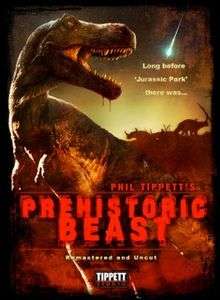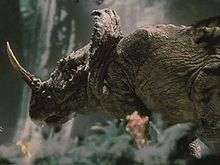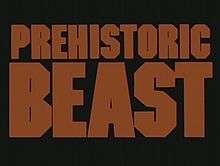Prehistoric Beast

Prehistoric Beast is a ten-minute-long experimental animated film conceived, supervised and directed by Phil Tippett in 1984. This sequence is the first film produced by the Tippett Studio, founded by Tippett. Made with the go motion animation technique, scenes from Prehistoric Beast were included in the 1985 full-length documentary Dinosaur!, first aired on CBS in the United States on November 5, 1985.[1]
Content
This short film depicts the chase and predation of a Monoclonius (or maybe a Centrosaurus, see below) by a Tyrannosaurus (or maybe a closely related genus, see below). The short opens with a tracking shot in the middle of a forest at night: the Tyrannosaurus is busy eating a dead Edmontosaurus. It is finishing the carcass. The next morning, a herd of Monoclonius is seen grazing. One member wanders into the forest to find more food. It finds a field of flowers and begins grazing. It wanders in further and starts to be hunted by the same Tyrannosaurus. The Tyrannosaurus steps on a twig, which makes the Monoclonius wary. The Monoclonius lets out a trumpet to signal the herd, then, possibly curious, keeps walking deeper into the forest. It soon stumbles upon the remains of the Edmontosaurus killed by the Tyrannosaurus. While the Monoclonius ponders over the carcass, the Tyrannosaurus sneaks up from behind. The Tyrannosaurus begins the battle by attacking the Monoclonius and biting hard on its back. The Monoclonius manages to break free from its enemy’s jaws and gores the Tyrannosaurus in its shin with its nasal horn, but this apparently enrages the Tyrannosaurus, which then corners it near some trees. The Monoclonius lets out one last cry before it is presumably killed. The Monoclonius herd start to call out for their missing member, not knowing that it has been killed. The Tyrannosaurus is next seen trying to find a place to sleep and digest its meal.
Potential inconsistency
The herbivore in the short could be identified as a Monoclonius but it also could be a Centrosaurus since some scientists already suggested that both genera are synonyms with Centrosaurus. Specimens of both genera, whether or not synonymised with Centrosaurus, are found in close stratigraphic ranges: from 77 million years ago (Ma) to 74.8 Ma for Monoclonius and from 76.5 Ma to 75.5 Ma for Centrosaurus. Even if considered as separated genera (not synonyms), Centrosaurus' temporal range is completely overlapped by Monoclonius' own temporal range (of course only in the cases when the affected fossil remains are attributed to Monoclonius).
But whether or not Monoclonius is a synonym of Centrosaurus, to consider that the meat-eater depicted in the short is a Tyrannosaurus engages an unavoidable inconsistency because the temporal range of Tyrannosaurus specimens doesn't start before the extinction of the Monoclonius/Centrosaurus morphotype. The latter spans in a stratigraphic range where several carnivore dinosaurs were morphologically very similar to Tyrannosaurus, sharing the same period and geographical area than Monoclonius/Centrosaurus. A few examples of such carnivore dinosaurs are the genera Daspletosaurus, Gorgosaurus or Albertosaurus. Thus, Prehistoric Beast can be considered as a scientifically consistent short film only if the meat-eater shown in the film is assumed to be one of such tyrannosaurids, like Daspletosaurus, Gorgosaurus or Albertosaurus for example, but not a Tyrannosaurus.
When some of these Prehistoric Beast sequences were added to the 1985 documentary Dinosaur!, Christopher Reeve, who hosted the show, named both animals respectively Monoclonius and Tyrannosaurus rex, thus being inconsistent. Nevertheless, it is worth mentioning that a 1993 Canadian documentary titled Dinosaurs: Messages in Stone[2] reused special effects sequences from Dinosaur! and Prehistoric Beast under authorization. In the ending credits of Dinosaurs: Messages in Stone, the affected species by the reused sequences are mentioned as Duckbill, Daspletosaurus and Struthiomimus, thus being consistent for considering the meat-eater as a Daspletosaurus and not a Tyrannosaurus.
Prelude of a full-length documentary

Prehistoric Beast was only released in specialized animation festivals, but it convinced Robert Guenette and Steven Paul Mark to request Tippett's skills in order to transform it in a full-length documentary. They then asked Tippett to realize new sequences with other dinosaur species, and the Prehistoric Beast material was added to the new one, resulting on Dinosaur! in 1985. Tippett had already participated in The Empire Strikes Back (1980), animating the tauntauns seen in the film, and his experimental work on Prehistoric Beast and Dinosaur! served to the animated dinosaurs sequences he made some years later for Jurassic Park (1993).
Digital re-release

On April 6, 2011, the Tippett Studio had published on its YouTube official channel a digital restoration of the short.[3]
Legacy
As for the subsequent documentary Dinosaur!, Phil Tippett, while making Prehistoric Beast, received assistance from ILM stop-motion animators Randy Dutra (who made the dinosaur molds and skins) and Tom St. Amand (who made the inner articulated metallic skeletons of the dinosaurs).[4]
In the 1933 film King Kong, a Stegosaurus attacks the film characters and after having killed it by gun fire one of the characters identifies it as being "a prehistoric beast". This line, taken from the original 1933 King Kong film, inspired Phil Tippett when giving a title to his 1984 animated short film.[5] An excerpt from this King Kong scene is shown in the final 1985 documentary Dinosaur!, as a reference to Prehistoric Beast, the short sequence by which it was preceded.
References
- ↑ 1980s section from Primeval Time, a dinosaurs documentaries specialised website
- ↑ Dinosaurs: Messages in Stone (1993), hosted by Leslie Nielsen, directed by John Robichaud, produced by Prehistoric Productions Ltd.
- ↑ Prehistoric Beast digital restoration, as published on April 6 2011 by the Phil Tippett Studio's official channel in Youtube
- ↑ Animator Tom St. Amand filmography, TCM.com
- ↑ Movie Magic: Behind the Scenes - Dinomania (The Discovery Channel, 1996)
External links
- Prehistoric Beast on IMDb
- Dinosaur! on IMDb